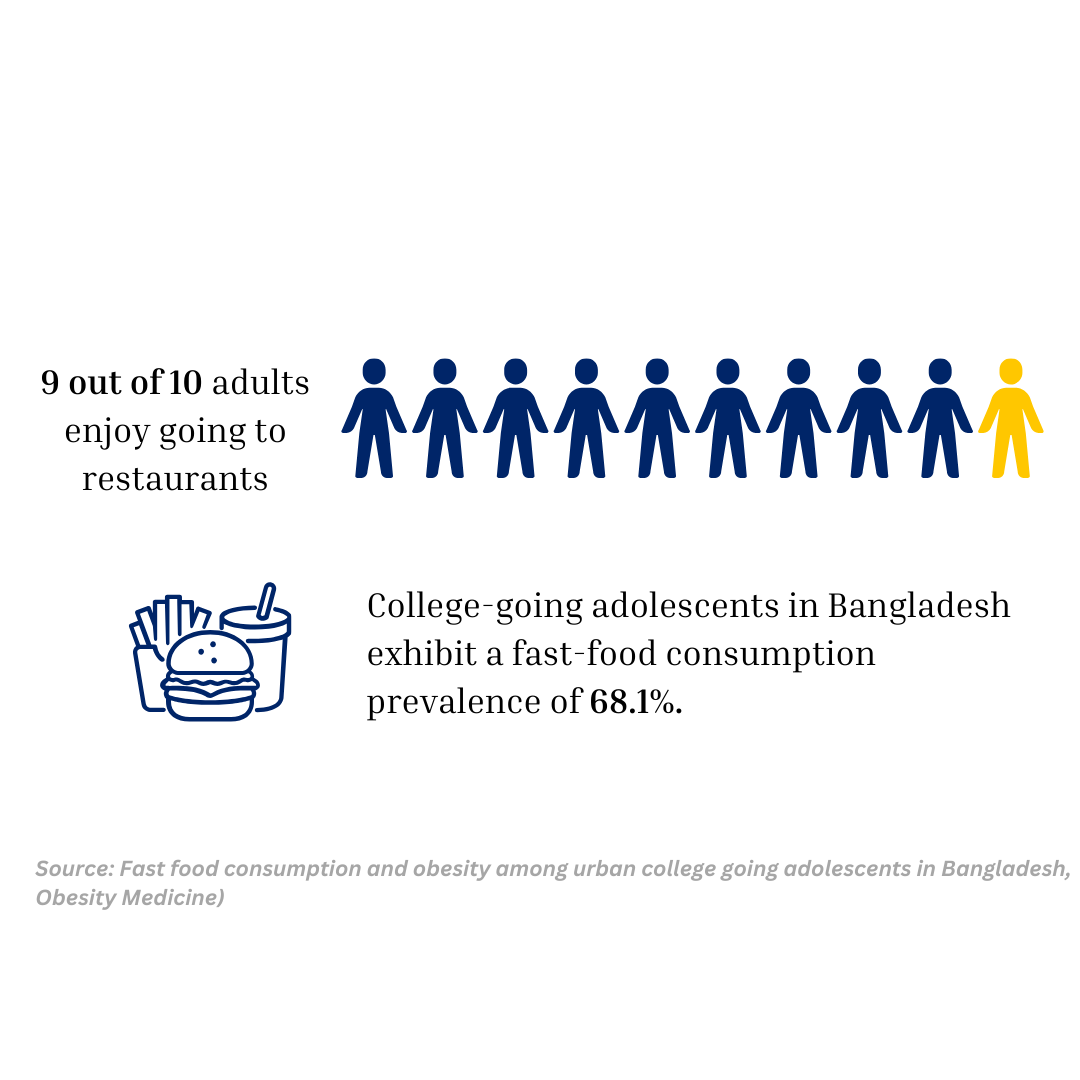"Beyond the delicious aromas roaming the streets of Bangladesh, the restaurant industry is a complex ecosystem where passionate chefs and savvy business minds collaborate to create memorable dining experiences. But with sizzling competition and ever-evolving consumer preferences, this industry is a melting pot of Opportunities"





In the food service industry, structure charts categorize establishments into three primary groups: fast food restaurants, cafeterias, and traditional restaurants. Fast food joints prioritize quick service and affordability, featuring a streamlined menu of pre-prepared items and often utilizing drive-thrus and take-out services. Popular chains like BFC, KFC, and Pizza Hut fall into this category. Cafeterias operate on a self-service model, offering a variety of pre-made dishes at a fixed price or per item. Found in places like schools, hospitals, and office buildings, they serve large volumes of customers with short dining times and may specialize in specific cuisines or dietary needs.
The restaurant industry is diverse, encompassing various types of establishments, each with its own distinct business model. Fast food restaurants prioritize quick service and affordability, offering pre-made meals with a limited menu to cater to customers seeking convenience and speed. Cafés, on the other hand, provide a relaxed atmosphere for socializing, studying, or working, serving coffee, tea, pastries, and light meals.
Dine-in restaurants offer a sit-down dining experience with waiter service, boasting a wide variety of menu options for those seeking a traditional dining experience. They can further be classified into singular establishments, which are independent and known for their unique menus and personalized service, and chain restaurants, which are part of larger corporations, providing consistency and familiarity to customers.
In-hotel restaurants, located within hotels, cater to both guests and the general public, offering convenience and often featuring high-quality food and service. Food courts, found in shopping malls or high-traffic areas, are collections of multiple fast-food restaurants under one roof, providing a diverse range of food options and a communal dining area. These establishments can also be divided into singular fast-food outlets, offering unique food choices, and chain restaurants, providing familiar menu items and a consistent dining experience.
The revenue drivers of the Restaurant and Food Service Industry in Bangladesh is influenced by the following factors:
1. Rising disposable incomes: Increased disposable incomes allow consumers to spend more on dining out experiences.
2. Urbanization: Growing urban populations create demand for convenient and diverse food options.
3. Location: A restaurant located in a high-traffic area or a popular neighborhood can attract more customers.
4. Technological advancements: Online ordering, delivery platforms, and mobile payment solutions enhance customer convenience and accessibility.
5. Shifting consumer preferences: Consumers increasingly seek unique culinary experiences, personalized options, and healthy food choices.
Recent cost driving factors of the Restaurant and Food Service Industry in Bangladesh include:
1. Rising food and beverage costs: Fluctuations in food prices due to factors like weather, supply chain disruptions, and global market dynamics has significantly impacted profit margins.
2. Equipment and Maintenance: Restaurants need a variety of equipment to operate, from kitchen appliances to POS systems. These items can be expensive to purchase and maintain.
3. Rent and occupancy costs: The cost of renting or owning restaurant space can be a major expense, especially in prime locations.
4. Technology costs: Implementing and maintaining technology solutions like online ordering platforms or point-of-sale systems can incur significant costs.
The Porter’s Five Forces analysis for the Restaurant and Food Service Industry in Bangladesh are outlined below. These factors impact how businesses compete and conduct business in Bangladesh's Restaurant and Food Service sector, hence defining the sector's strategic landscape.
1. Competitive Rivalry: The restaurant industry is highly competitive, with numerous players vying for market share. This intense competition drives innovation, price wars, and the need for effective differentiation strategies.
2. Bargaining Power of Buyers: Customers hold significant bargaining power due to the abundance of options available. They can easily switch between restaurants based on factors like price, quality, convenience, and service.
3. Bargaining Power of Suppliers: The bargaining power of suppliers varies depending on the specific ingredients and the supplier's market share. For instance, large restaurant chains may have more leverage when negotiating prices with major food distributors compared to independent restaurants.
4. Threat of New Entrants: The threat of new entrants is moderately high, as the barrier to entry in certain segments like fast food is relatively low. However, establishing a successful restaurant requires significant capital, expertise, and brand recognition, particularly when competing with established chains.
5. Threat of Substitutes: The threat of substitutes is high, with consumers having various alternatives to eating out, including cooking at home, grocery delivery services, and convenience store meals.
The trajectory of Bangladesh's restaurant industry is influenced by several notable trends. Firstly, there's a steady growth trajectory, with the market size estimated at USD 3.79 billion in 2024, expected to nearly double to USD 7.47 billion by 2029, reflecting a robust compound annual growth rate (CAGR) of 14.50% during the forecast period. This expansion is accompanied by a diversification of restaurant types, ranging from small-scale fast-food outlets to upscale exotic dining establishments, including the rising popularity of ethnic cuisines such as Korean, Japanese, Middle Eastern and Indian. Moreover, Quick Service Restaurants (QSRs) hold significant sway, particularly among Bangladesh's youthful demographic, with over 50% of the population under 25 years old. The Bangladeshi QSR market size was USD 1,712.4 million in 2023 and is poised to grow to USD 2,653.4 million by 2030. Additionally, the restaurant delivery sector is witnessing a surge, with projections indicating a revenue increase from US$112.00 million in 2024 to US$147.60 million by 2028, representing a steady annual growth rate. Lastly, the industry's expansion also translates into substantial employment opportunities, underscoring its role as a key economic driver in the nation's future.
Contact us today to schedule a free demo of FLOW - your all-in-one business management tool.
